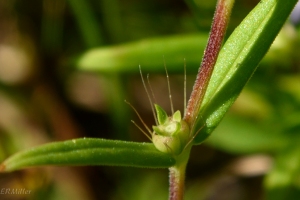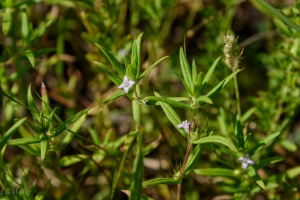poorjoe, rough buttonweed
Diodella teres
(formerly Diodia teres)
Rubiaceae
! was really happy to find a member of the Rubiaceae growing in Serpentine Barrens Conservation Park, and even happier to realize it’s a “new-to-me” species. And then I was surprised to learn that it’s considered a nuisance weed of turfgrass. Type “poorjoe” into Google and it will autocomplete to the phrase “poorjoe weed”, and then you’ll find tips on how to eradicate it.
Poorjoe likes disturbed sites and nutrient-poor soils, like in the clear-cut area under power lines where I found these. It’s an annual plant that might sprawl a bit, but is more likely to have ascending stems. The flowers are typically lavender-colored, but there’s some variation and, like a few of the Houstonia species I’ve written about, can appear to be white (or actually be white). They’re borne in the leaf axils. The leaves are sessile, with stipules that form little cups that contain a few long bristles. The stem is often reddish-brown.
As nuisance madders go, this one isn’t nearly as bad as its cousin Virginia buttonweed (Diodia virginiana). Google that common name, and the whole first page of results will be how to control (kill) it in lawns. Virginia buttonweed is a perennial, sprawling rather than ascending, with white flowers, and no bristles in the leaf axils.
Diodella teres ranges from southern New England south through Florida and west through central Texas, with a few occurrences in the desert Southwest as well. In Maryland it can be found in the Piedmont and parts of the Coastal Plain.
What constitutes a “weed”, anyway? I like this definition: “a plant growing where it isn’t wanted”. I saw only a few poorjoe plants in an area full of invasive aliens, so I’d hardly name it a weed in that context.




Pingback: Happy New Year! | Elizabeth's Wildflower Blog
My dog eats the poor joe buttonweed when her stomach is upset. This is the second dog I’ve had that searches specifically for this plant to eat.
Started eating small quantities of the Virginia Buttonweed; can’t find anything on PubMed regarding its nutritional profile. I understand there are a gazillion plant neutraceuticals to investigate but our poverty of at least testing for toxicity was a bit surprising seeing as its named after an American State – ah well, I’ve alerted my family just in case I keel over or grow wings
Poor Joe saved me!. Poor Joe started growing there and has stopped the erosion. I opted to let everything that wanted to grow on the 8 acre property grow and then I would pull out whatever I didn’t want (stickers and ragweed are the big ones). The wildflowers are just everywhere. But this tiny flower of the Poor Joe covers my front slope and I like it just fine.